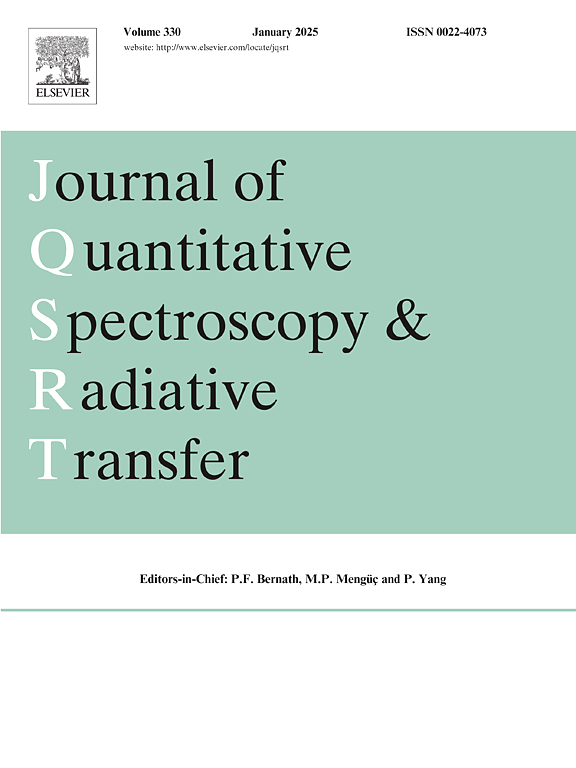蓝色激光在热铯蒸气中诱导出亮红色荧光
IF 1.9
3区 物理与天体物理
Q2 OPTICS
Journal of Quantitative Spectroscopy & Radiative Transfer
Pub Date : 2025-06-24
DOI:10.1016/j.jqsrt.2025.109549
引用次数: 0
摘要
我们用456nm激光辐射观察了Cs原子6S1/2→7P3/2跃迁共振的激光诱导荧光。它包括580-730 nm范围内的红色发射线和852 nm处的突出线,对应于6P3/2→6S1/2跃迁。采用长度为1cm的t型全蓝宝石电池,内含Cs原子蒸汽,可加热至500℃。研究了852 nm处激光诱导荧光(LIF)功率与细胞温度的关系。最大LIF功率在130°C时达到,而在300°C左右观察到显著下降。在130℃时,852 nm处的多普勒展宽LIF光谱发生自转换,形成两个明显的峰。研究了852 nm处LIF功率与456nm辐射功率的关系。Cs电池作为一种高效的滤光片和下转换器,可以有效地将456nm的辐射转换为852 nm的辐射。本文章由计算机程序翻译,如有差异,请以英文原文为准。

Blue laser induced bright red fluorescence in hot cesium vapor
We have observed laser-induced fluorescence using 456 nm laser radiation, resonant with the 6S 7P transition in Cs atoms. It includes red emission lines in the range of 580-730 nm and a prominent line at 852 nm corresponding to the 6P 6S transition. A T-shaped all-sapphire cell with a length of 1 cm, containing Cs atomic vapor and capable of being heated up to 500 °C, was used. The laser-induced fluorescence (LIF) power at 852 nm was investigated as a function of the cell temperature. The maximum LIF power was achieved at 130 °C, while a significant decrease was observed around 300 °C. At 130 °C, the Doppler-broadened LIF spectrum at 852 nm exhibited self-conversion, resulting in the formation of two distinct peaks within the spectrum. The LIF power at 852 nm was also studied as a function of the 456 nm radiation power. The Cs cell demonstrated potential as an efficient optical filter and down-converter, effectively transforming 456 nm radiation into 852 nm radiation.
求助全文
通过发布文献求助,成功后即可免费获取论文全文。
去求助
来源期刊
CiteScore
5.30
自引率
21.70%
发文量
273
审稿时长
58 days
期刊介绍:
Papers with the following subject areas are suitable for publication in the Journal of Quantitative Spectroscopy and Radiative Transfer:
- Theoretical and experimental aspects of the spectra of atoms, molecules, ions, and plasmas.
- Spectral lineshape studies including models and computational algorithms.
- Atmospheric spectroscopy.
- Theoretical and experimental aspects of light scattering.
- Application of light scattering in particle characterization and remote sensing.
- Application of light scattering in biological sciences and medicine.
- Radiative transfer in absorbing, emitting, and scattering media.
- Radiative transfer in stochastic media.

 求助内容:
求助内容: 应助结果提醒方式:
应助结果提醒方式:


